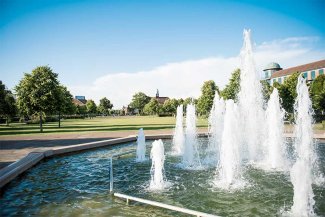Barry Parker 1867-1947, Architecture of Harmony, Sunlight and Equality by Vicky Axell, is published this week by Letchworth Heritage Foundation.
Barry Parker, along with his business partner, Raymond Unwin, was the architect and town planner for Letchworth, which, in 1904, was the world’s first garden city. Letchworth subsequently became the template for the garden cities model around the world. Earlier this year, an exhibition about Barry Parker’s work at Letchworth’s Broadway Gallery brought him firmly into the limelight, focusing not just on his work as a town planner, but also as an architect, furniture designer and artist. Vicky Axell, who curated the exhibition, Barry Parker, Architecture for All, is also the author of this new book.
Vicky Axell says, “Parker is an undiscovered genius of the Arts & Crafts movement. He had a unique approach to architecture with a big social conscience. He believed in building homes for all regardless of people’s wealth and social stature. His ethos focused on ‘harmony, sunlight and equality’, which meant that the homes he designed, in Letchworth and throughout the UK and around the world, were functional and beautiful; filled with light; affordable; and they also fitted into their surrounding environment.”
Barry Parker was born in Chesterfield in 1867 and trained as an architect in Derby and Altrincham. He lived in Letchworth from 1904 until his death in 1947. He was married with two children. The book is the culmination of four year’s work by the museum service’s volunteers and staff to digitise the 4000 items in the Parker Collection.
The book Barry Parker 1867-1947 is as simply yet beautifully written and designed as a Barry Parker home. It is a valuable history, a compelling story, and also a stunning and collectable art book, with over 400 drawings, photographs and paintings all curated from Letchworth’s Garden City Collection. This book is an important celebration of a talented artist and architect who deserves to be recognised for his contribution to the garden city movement. In addition to his design work in Letchworth, Parker worked on the town plan for Oporto in 1915, followed by the Jardim América garden suburb of São Paulo from 1917-1919. Parker’s approach about how to live well with less is particularly relevant today.
“Everything about Letchworth and subsequent garden cities starts with Parker,” says Vicky Axell, who has been Curator of the Garden City Collection for seventeen years. “I have fallen in love with Parker’s approach to design and living and his celebration of harmony, sunlight and equality. I find it so inspiring to think that you can enjoy the simple things of life – sitting by a fire and having a cup of tea - in a simply yet beautifully designed home.”
This approach to life and design is increasingly being celebrated today thanks to a recent crop of new magazines with titles including Breathe and The Simple Things. It’s also worth noting that Parker’s belief in maximising light in new homes would be equally appreciated by the architect and Grand Designs’ presenter, Kevin McCloud. And the airy, minimalist interiors created by Parker, still enjoyed by many Letchworth residents today, could easily feature in high profile contemporary design magazines such as Wallpaper or World of Interiors.
Barry Parker 1867-1947, Architecture of Harmony, Sunlight and Equality, has been published just in time for Christmas. This charming, stylish and immaculately researched book makes the perfect gift for anyone who lives in or is interested in Letchworth and other garden cities throughout the world. It is equally valuable for students of, or professionals working in, architecture, art and design, and for lovers of interior design, good living and simple and sustainable lifestyles.


